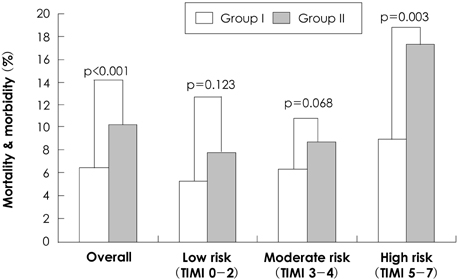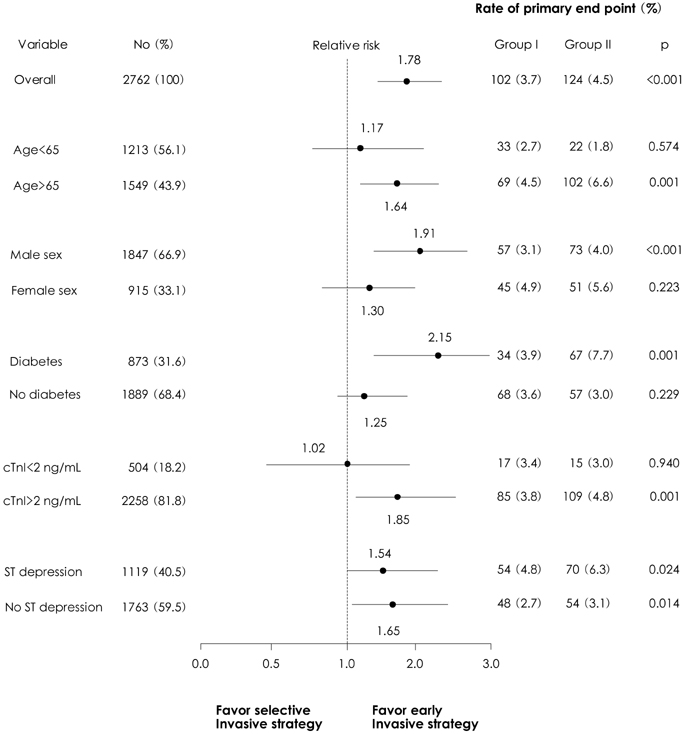Korean Circ J.
2007 Nov;37(11):550-558. 10.4070/kcj.2007.37.11.550.
In-Hospital Outcome According to the Initial Management and the "Thrombolysis in Myocardial Infarction Risk Score" of Acute Non-ST Segment Elevation Myocardial Infarction
- Affiliations
-
- 1Korea Acute Myocardial Infarction Registry (KAMIR) Study Group of the Korean Circulation Society, Korea. myungho@chollian.net
- KMID: 1909616
- DOI: http://doi.org/10.4070/kcj.2007.37.11.550
Abstract
-
BACKGROUND AND OBJECTIVES: The current guidelines recommend an early invasive strategy for patients suffering with non-ST segment elevation myocardial infarction (NSTEMI). However, there is still debate about the timing of revascularization in patients with NSTEMI. To analyze the clinical efficacy of the timing of revascularization, we compared the in-hospital clinical outcome of NSTEMI patients from the Korea Acute Myocardial Infarction Registry (KAMIR) between the early and selective invasive therapeutic groups.
SUBJECTS AND METHODS
Between Nov. 2005 and Apr. 2007, 2762 acute NSTEMI patients (mean age=64.6+/-12.8 years, 1847 males) were enrolled in the KAMIR. The therapeutic strategy of NSTEMI was categorized into early invasive treatment (within 48 hours, Group I mean age: 63.1+/-13.1 years, 1085 males) and selective invasive treatment (Group II mean age: 66.5+/-12.1 years, 762 males). The initial clinical status and the in-hospital mortality and morbidity rate were compared between these two groups. The in-hospital outcomes were also compared between the two groups according to each level of the Thrombolysis In Myocardial Infarction (TIMI) risk score.
RESULTS
There were significant differences in the mortality and morbidity rate between the groups (6.5% vs. 10.3%, respectively, p<0.001). According to TIMI risk score, there were no significant differences of mortality and morbidity for the low to moderate risk patients (5.3% vs. 7.8%, respectively, p=0.123 for the risk score 0-2, 6.4% vs. 8.7%, p=0.139 for the risk score 3-4).
CONCLUSION
Early invasive treatment improves the hospital outcome for the high-risk NSTEMI patients. The use of abciximab, a low ejection fraction, a high Killip class, a high TIMI risk score and old age are the predictive factors of in-hospital mortality and morbidity.
MeSH Terms
Figure
Reference
-
1. Patel MR, Chen AY, Peterson ED, et al. Prevalence, predictors, and outcomes of patients with non-ST-segment elevation myocardial infarction and insignificant coronary artery disease: results from the can rapid risk stratification of unstable angina patients suppress adverse outcomes with early implementation of the ACC/AHA guidelines (CRUSADE) initiative. Am Heart J. 2006. 152:641–647.2. Hamm CW, Braunwald E. A classification of unstable angina revisited. Circulation. 2000. 102:118–122.3. Bertrand ME, Simoons ML, Fox KA, et al. Management of acute coronary syndromes in patients presenting without persistent ST-segment elevation. Eur Heart J. 2002. 23:1809–1840.4. Braunwald E, Antman EM, Beasley JW, et al. ACC/AHA 2002 guideline update for the management of patients with unstable angina and non-ST-segment elevation myocardial infarction-summary article: a report of the American College of Cardiology/American Heart Association task force on practice guidelines (Committee on the Management of Patients with Unstable Angina). J Am Coll Cardiol. 2002. 40:1366–1374.5. de Winter RJ, Windhausen F, Cornel JH, et al. Early invasive versus selectively invasive management for acute coronary syndromes. N Engl J Med. 2005. 353:1095–1104.6. Hirsch A, Windhausen F, Tijssen JG, Verheugt FW, Cornel JH, de Winter RJ. Long term outcome after an early invasive versus selective invasive treatment strategy in patients with non-ST-elevation acute coronary syndrome and elevated cardiac troponin T (the ICTUS trial): a follow-up study. Lancet. 2007. 369:827–835.7. Biondi-Zoccai GG, Lotrionte M, Agostoni P, et al. Benefits of clopidogrel in patients undergoing coronary stenting significantly depend on loading dose: evidence from a meta-regression. Am Heart J. 2007. 153:587–593.8. Cannon CP, Braunwald E, McCabe CH, et al. Intensive versus moderate lipid lowering with statins after acute coronary syndromes. N Engl J Med. 2004. 350:1495–1504.9. Sabatine MS, Antman EM. The thrombolysis in myocardial infarction risk score in unstable angina/non ST segment elevation myocardial infarction. J Am Coll Cardiol. 2003. 41:Suppl. 89S–95S.10. Findlay IN, Cunningham AD. Definition of acute coronary syndrome. Heart. 2005. 91:857–859.11. Metha RH, Roe MT, Chen AY, et al. Recent trends in the care of patients with non-ST-segment elevation acute coronary syndromes: insights from the CRUSADE initiative. Arch Intern Med. 2006. 166:2027–2034.12. Alexander KP, Newby LK, Cannon CP, et al. Acute coronary care in the elderly: part I. non-ST-segment-elevation acute coronary syndromes: a scientific statement for healthcare professionals from the American Heart Association Council on Clinical Cardiology: in collaboration with the Society of Geriatric Cardiology. Circulation. 2007. 115:2549–2569.13. Srinivas VS, Garg S, Negassa A, Bang JY, Monrad ES. Persistent sex difference in hospital outcome following percutaneous coronary intervention: results from the new york state reporting system. J Invasive Cardiol. 2007. 19:265–268.14. Aronson D, Hammerman H, Kapeliovich MR, et al. Fasting glucose in acute myocardial infarction: incremental value for long-term mortality and relationship with left ventricular systolic function. Diabetes Care. 2007. 30:960–966.15. Shim CY, Kim JB, Choi SH, et al. The prognostic significance of ST segment depression score in acute non ST elevation myocardial infarction. Korean Circ J. 2004. 34:1182–1187.16. Waxman DA, Hecht S, Schappert J, Husk G. A model for troponin I as a quantitative predictor of in-hospital mortality. J Am Coll Cardiol. 2006. 48:1755–1762.17. Thrombosis in Myocardial Ischemia. Effects of tissue plasminogen activator and a comparison of early invasive and conservative strategies in unstable angina and non-Q-wave myocardial infarction: results of the TIMI IIIB trial. Circulation. 1994. 89:1545–1556.18. Boden WE, O'Rourke RA, Crawford MH, et al. Outcomes in patients with acute non-Q-wave myocardial infarction randomly assigned to an invasive as compared with a conservative anagement strategy. N Engl J Med. 1998. 338:1785–1792.19. Wallentin L, Lagerqvist B, Husted S, Kontny F, Stahle E, Swahn E. Outcome at 1 year after an invasive compared with a non-invasive strategy in unstable coronary-artery disease: the FRISC II invasive randomised trial. FRISC II Investigators. Fast Revascularisation during Instability in Coronary artery disease. Lancet. 2000. 356:9–16.20. Cannon CP, Weintraub WS, Demopoulos LA, et al. Comparison of early invasive and conservative strategies in patients with unstable coronary syndromes treated with the glycoprotein IIb/IIIa inhibitor tirofiban. N Engl J Med. 2001. 344:1879–1887.21. Fox KA, Henderson RA, Clayton TC, et al. Interventional versus conservative treatment for patients with unstable angina or non-ST-elevation myocardial infarction: The British Heart Foundation RITA 3 randomised trial. Lancet. 2002. 360:743–751.22. Kim JH, Jeong MH, Rhew JY, et al. The long-term clinical outcomes of low molecular weight heparin combined with platelet glycoprotein IIb/IIIa Inhibitor in patients with acute coronary syndrome. Korean Circ J. 2003. 33:559–567.23. Cavallini C, Savonitto S, Violini R, et al. Impact of the elevation of biochemical markers of myocardial damage on long-term mortality after percutaneous coronary intervention: results of the CK-MB and PCI study. Eur Heart J. 2005. 26:1494–1498.24. Roe MT, Mahaffey KW, Kilaru R, et al. Creatine kinase-MB elevation after percutaneous coronary intervention predicts adverse outcomes in patients with acute coronary syndromes. Eur Heart J. 2004. 25:313–321.25. Westerhout CM, Fu Y, Lauer MS, et al. Short-and long-term risk stratification in acute coronary syndromes: the added value of quantitative ST-segment depression and multiple biomarkers. J Am Coll Cardiol. 2006. 48:939–947.26. Lyon R, Morris AC, Caesar D, Gray S, Gray A. Chest pain presenting to the emergency department: to stratify risk with GRACE or thrombolysis in myocardial infarction? Resuscitation. 2007. 74:90–93.27. Ventura HO. Benefits of inpatient initiation of beta-blockers. Am Heart J. 2004. 148:944–950.28. Dagenais GR, Pogue J, Fos K, Simoons ML, Yusuf S. Angiotensin-converting-enzyme inhibitors in stable vascular disease without left ventricular systolic dysfunction or heart failure: a combined analysis of three trials. Lancet. 2006. 368:581–588.29. Hong YJ, Jeong MH, Lim SY, et al. The long-term clinical outcomes of combination therapy with angiotensin II type I receptor blocker and simvastatin after percutaneous coronary intervention. Korean Circ J. 2005. 35:877–882.30. Ugo F, Ardissino D. Low-molecular-weight heparins in acute coronary syndrome: acquired results and new perspectives. G Ital Cardiol. 2006. 7:771–779.
- Full Text Links
- Actions
-
Cited
- CITED
-
- Close
- Share
- Similar articles
-
- Retroperitoneal Hemorrhage after Thrombolysis in ST Elevation Myocardial Infarction
- Acute Myocardial Infarction by Right Coronary Artery Occlusion Presenting as Precordial ST Elevation on Electrocardiography
- Differences in Clinical Outcomes Between Patients With ST-Elevation Versus Non-ST-Elevation Acute Myocardial Infarction in Korea
- Coronary Slow Flow Phenomenon Leads to ST Elevation Myocardial Infarction
- Effect of Angina Pectoris before Acute Myocardial Infarction on Degree of Residual Stenosis after Successful Coronary Thrombolysis



